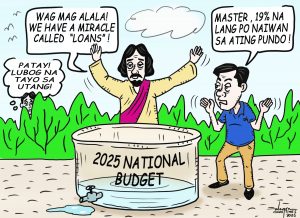Whatever solution the government does to solve a particular problem will always create another problem to certain sectors of the population. So it is not surprising that in the implementation of the measure there will be complaints manifested either in murmur or in a more overt even offensive manner.
One such solution adopted by government is the easing of requirements for Filipino businessmen to import rice from other countries to meet the needs of the Philippine population. This government action is more popularly called the Rice Tariffication Law. Of course the sector that claims to be adversely affected with the law would probably prefer to call the measure “notorious” rather than popular.
But what exactly is the Rice Tariffication Law and what was the problem then prevailing in the country that it was intended to solve?
The problem really was a major one as it affects the gamut of Philippine society, the very people that make up the Filipino race. It was of course the lack of production in the remaining agricultural lands devoted to rice. It is not surprising though because the once massive lands planted to the crop are now converted into residential subdivisions and industrial estates.
Moreover, it is not just the agricultural land area that is diminishing. The number of people engaged in rice farming is dwindling as well. Should we put the blame on the parent farmers who have, in all their lives, been looking forward to having their children work in the confines of air-conditioned offices or earn dollars in prestigious companies abroad; they who end up converting their land holdings into shares in large property development companies with a promise of huge return on investments? Should we blame the greedy rice traders who do everything within their resources to control the majority small farmers so they can dictate the palay prices? Or should we point fingers on the present generation of Filipinos that refuse to dirty their hands with soil?
But whatever, the problem is already in our midst. And those who are suffering are the Filipino consumers of the food staple between 80 tom 90 percent belonging to the less privileged sector of the country’s population.
In other words, the Filipinos who stand to benefit from the easing of rice importation requirements including volume are massive in number. They are the majority of the population; the people who depend on rice as their main food on the table, or on road sides.
Those who are put at a disadvantage – or claiming to be –are hardly twenty percent. And they are not the sufferers per se` because they are those who can afford to buy rice even at a much higher price. What they claim losing is only a minuscule of their profit (for rice traders) and lower production income (for the farmers).
But seemingly there is a huge disconnect between the prevailing rice prices in the market and the supposedly in the farm gates. Even as the farmers are claiming the buying price of their produce has gone to a low of P15.28 per kilogram of dried palay last October the prices of local rice in the markets are still in the range of from P45 as lowest to as much as P60 the highest for best variety. As to the imported rice the consumers can have the staple at between P35 to P40 a kilo.
And who are buying the rice from the Filipino farmers? Still they are the grains traders who have devised a scheme that systematically “enslaves” the farmers with them. They are the ones who offer farmers cash advances to buy farm inputs, pay for farm labor cost since the farmers’ children are either in school or are working somewhere else and not helping their parents in the farm.
What then can the remaining Filipino rice farmers do? They have to allow themselves to be subjected to the whims and caprices of the shrewd grains traders. The farmers have to agree with them on their dictated prices of palay so they (farmers) can have their produce disposed of, dried, milled and stored in the businessmen’s facilities.
If the farmers refuse the grain traders’ buying price they stand the risk of having to immediately pay their advances and move to other drying, milling and storage depots.
Of course the government must admit that it is on these aspects that it is very much wanting. And if there are current efforts by government to build new support facilities for rice farmers, or even providing them with financial subsidies for the procurement of farm inputs, it’s already too late of the day. The farmers, mostly the smaller and individual ones, are indebted up to the neck from private rice traders.
We see this bondage with the scheming grains businessmen as the hardest to break. If at all, the government is bent on rescuing them, it has to make more money available to the farmers in the easiest of terms. And this is not easy to come by.
For the meanwhile, some better-off Filipinos must do little sacrifices as a result of the existing measure for the good of the many who are disadvantaged under the system shrewdly devised by the rice traders.
But government of course must be sincere in easing the farmers’ plight by making good its promise of delivering them from enslavement by the greedy businessmen. It has to make the gains in the rice tariffication law readily available to the farmers needing assistance and not to the pockets of corrupt officials and pseudo farmers.

